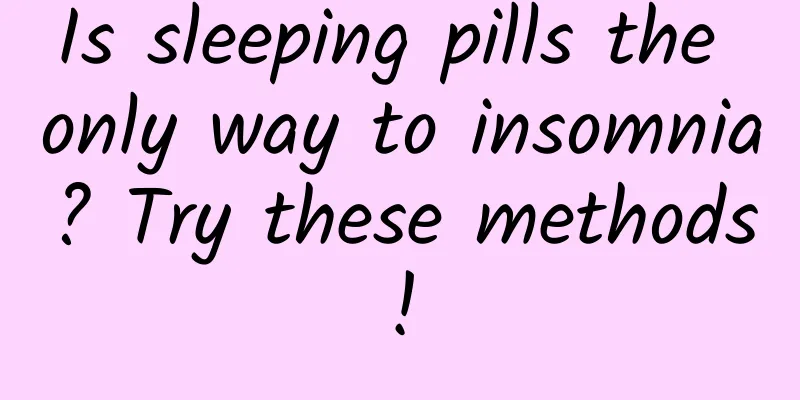Is sleeping pills the only way to insomnia? Try these methods!

|
In the previous article, we learned what a normal sleep cycle is and what insomnia is. So, how to treat insomnia? First of all, we need to know that insomnia is treatable and preventable, and it is not terrible to suffer from insomnia. The treatment of insomnia mainly includes drug therapy, psychotherapy, physical therapy, and other treatments. You can choose the following treatments according to the severity of your symptoms. Come and take a look with Xiao H! Drug treatment: Currently commonly used sleeping pills include three main categories: benzodiazepines, barbiturates and others. The following guidelines should be followed when using sleeping pills: Use it when necessary and temporarily. Do not use it for a long time. It is not recommended to use it for more than 4 weeks, otherwise tolerance and dependence will occur. There are many types of sleeping pills, and there are certain dosage requirements. You can't just buy medicine for treatment; Stop the medication gradually and reduce the dosage slowly to prevent rebound insomnia after stopping the medication. Some people are overly afraid of sleeping pills, worrying that they will become dependent on them or that taking them means they are very serious, so they refuse to take them. It is certainly good not to need to take sleeping pills, but if insomnia is severe and causes long-term pain, medication should be used under the guidance of a doctor to avoid abuse. Psychotherapy The vast majority of insomnia is caused by psychological factors, so psychotherapy is the first choice for insomnia, and the long-term efficacy of psychotherapy is better than that of drug therapy. Specifically include sleep hygiene education, cognitive therapy, sleep restriction, stimulus control, relaxation therapy, music therapy, etc. Sleep hygiene education Sleep hygiene education is the cognitive basis for improving insomnia. You can adjust your sleep state according to the following methods: 01Eliminate bad sleeping habits and establish scientific sleeping habits that suit you; 02Try to keep the time you go to bed and get up at the same time every day. Even if you go to bed very late at night, you should get up on time the next day. 03Build a good sleeping environment, quiet, light-proof, comfortable bedding, etc. are all necessary conditions; 04 Don’t do anything unrelated to sleep in bed, such as reading, watching TV, chatting, etc. 05 Go to bed only when you feel sleepy. If you cannot fall asleep within 20 minutes, get up and do something peaceful and monotonous, and then go to bed again when you feel sleepy. 06 Do not drink stimulating beverages before going to bed, and try not to sleep during the day. If you must sleep, you can take a 30-minute nap. Cognitive therapy Many people do not have a very correct understanding of insomnia and are always overly worried about the harm of insomnia. Their understanding of insomnia is distorted, unreasonable, and negative, which directly affects the quality of sleep. For example, "you must sleep for 8 hours a day", "make up for more sleep during the day", "lie down more if you can't sleep", and "my life will be ruined if I don't sleep well" are all incorrect views. It is crucial to have the correct cognition. This method requires seeking the help of professionals to establish the correct cognition for yourself and accurately identify the problem. Sleep restriction Improve sleep by shortening or limiting the time in bed (but not less than 5 hours), which increases the insomniac's desire for sleep, prevents daytime naps or siestas, and makes it easier for them to fall asleep at night. Improve sleep efficiency, reduce non-sleeping time spent in bed, and improve sleep efficiency. Sleep efficiency = actual total sleep time ÷ time sleeping in bed × 100%. The normal person's sleep efficiency is around 95%. When the sleep efficiency is above 90% for several consecutive nights, it is allowed to increase the bed time by 15 minutes every day. When the sleep efficiency is below 80% for several consecutive nights, the bed time should be reduced by 15 minutes. When the sleep efficiency is between 80% and 90%, the bed time remains unchanged. Stimulus Control Stimulus control methods limit the time spent in bed while awake; these restrictions are intended to strengthen the association between the bed/bedroom/bedtime and rapid, robust sleep. The specific method is: lie down in bed only when you feel sleepy, and do not do things that are not related to sleep in bed. If you still cannot fall asleep after lying quietly in bed for 20 minutes, leave the bed or room and do something peaceful, and go to bed when you feel sleepy again. Relaxation therapy Lie on your back in bed, close your eyes slightly, relax all the muscles in your body, focus your attention on your hands and feet, and use the heaviness of your hands and feet to experience the degree of muscle relaxation. The heavier you feel, the more relaxed your muscles are. At the same time, take slow, even, deep breaths. Physical therapy Physical therapy is more scientific and effective, and is also an effective way to improve sleep quality: Light therapy can alter sleep cycles, so light therapy can be used to treat sleep rhythm disorders. Specific method: Expose the human body to strong light of 1000 lux for 1-2 hours, usually in the early morning or evening. Biofeedback therapy The treatment is carried out using a professional electromyography biofeedback device, and the treatment intensity is adjusted according to the insomniac's response. It can be used to relax muscles, reduce sympathetic nerve tension, and improve the brain's excitation and inhibition regulation functions, thereby achieving the purpose of treating insomnia. Repetitive transcranial magnetic stimulation Repetitive transcranial magnetic stimulation is a new neuroelectrophysiological technology. It uses the principle of electromagnetic induction to generate pulse current to non-invasively stimulate the ascending activation system sleep control area of the brainstem reticular formation. It is a non-invasive, radiation-free, simple to operate and safe treatment method. Multiple clinical studies have shown that repetitive transcranial magnetic stimulation is effective in treating insomnia. Music Therapy Music therapy is performed before bedtime, usually for 20-30 minutes, or longer for 40-60 minutes, with the volume not exceeding 60 decibels. If you have trouble falling asleep, you should choose lyrical, slow-tempo solo music; if you have a light sleeper and wake up easily, you can choose lyrical songs without obvious beats. Conclusion In conclusion, insomnia is treatable and preventable. It is not terrible to suffer from insomnia. Don't take insomnia too seriously. It is very important to maintain a calm emotional state. References: [1] Yin Guoyou. How to avoid misdiagnosis of insomnia, achieve good therapeutic effects and help you sleep soundly[M]. Nanchang: Jiangxi Science and Technology Press, 2019 [2] Lu Heng. 360 Questions Most Concerned by Insomnia Patients[M]. Wuhan: Hubei Science and Technology Press, 2015 [3] Liu Shuai, Zhang Bin. Interpretation of the “Guidelines for the Diagnosis and Treatment of Insomnia Disorders in China”[J]. Chinese Journal of Modern Neurological Diseases, 2017, 45(08): 1-6+125. Popular science article author: Yuan Mei, Bi Xia, Zhao Jiangxia Bi Xia, Doctor of Medicine, Chief Physician, Master Supervisor, is currently the Director of the Department of Rehabilitation Medicine, Zhoupu Hospital Affiliated to Shanghai University of Medicine and Medical Sciences, and the Vice President of the School of Rehabilitation, Shanghai University of Medicine and Medical Sciences. In 2010, 2018 and 2019, she was selected into the Excellent Discipline Leader and Leading Talent Training Program of the Health System of Pudong New Area. She has published 4 SCI papers and more than 30 core journal papers as the first author and corresponding author. Professional fields: stroke rehabilitation, fracture postoperative rehabilitation, spinal cord injury rehabilitation, artificial joint perioperative rehabilitation, hand injury rehabilitation, etc. Main academic positions: Member of the Geriatric Rehabilitation Branch of the Chinese Rehabilitation Medicine Association, Member of the Medical and Nursing Integration Committee of the Chinese Rehabilitation Medicine Association, Rehabilitation Committee Member of the Geriatric Rehabilitation Branch of the Chinese Medical Doctor Association, Executive Director of the Shanghai Rehabilitation Medicine Association, Member of the Physical Medicine and Rehabilitation Branch of the Shanghai Medical Association, Vice Chairman of the Rehabilitation Treatment Committee of the Shanghai Rehabilitation Medicine Association, Member of the Orthopedic Rehabilitation Committee of the Shanghai Rehabilitation Medicine Association, Member of the Spinal Cord Injury Rehabilitation Committee of the Shanghai Rehabilitation Medicine Association, Member of the Community Rehabilitation Committee of the Shanghai Rehabilitation Medicine Association, Member of the Sports Health and Rehabilitation Committee of the Shanghai Rehabilitation Medicine Association, Chairman of the Rehabilitation and Physiotherapy Committee of the Shanghai Pudong New Area Medical Association, and other academic positions. Yuan Mei is a therapist at the Department of Rehabilitation Medicine, Zhoupu Hospital Affiliated to Shanghai University of Medicine and Health Sciences. She holds a master's degree in rehabilitation therapy and has published three rehabilitation-related papers. Specializes in postpartum rehabilitation and rehabilitation of cervical and lumbar diseases. Funded by Shanghai Science and Technology Commission's Science Popularization Project (Project No.: 20DZ2311100) |
>>: When you are tired and sleepy at work, you can do these little tricks
Recommend
The characteristics of girls' development
A girl's body officially begins to develop du...
10 days pregnant, stomach pain
For expectant mothers who are just pregnant with ...
Difference between follicular phase and ovulatory phase
Women should pay attention to their own physical ...
Why do I have plaques in my carotid artery even though I don’t have the three highs? Should I take statins?
A friend told Huazi that he was diagnosed with ca...
What are the "danger signs" of atrial fibrillation? Pay attention to heart health in autumn and winter
The human heart needs to keep beating regularly. ...
Why do I feel a little stomach pain just after having an abortion?
Unexpected pregnancy not only hurts women psychol...
What is an ovarian dermoid cyst?
The ovaries are very important reproductive organ...
Leucorrhea is milky white like lotion
Everyone loves beauty, let alone women. However, ...
Decoding cirrhosis: the liver's "secret battle"
Author: Ma Xuemei, deputy chief physician of the ...
Chan Tui Decoction helps you sleep, while Danggui Huangqi Wolfberry Drink treats dysmenorrhea. Can the “ancient recipes” in Meng Hua Lu be used today?
Recently, the popular TV series "Dream of Sp...
What's going on with the blood clots in my period?
Under normal circumstances, there will be no fore...
Will I gain weight when my period comes?
Many people always misunderstand that they will g...
Why are the things of white-collar women bigger than those of ordinary people?
Among modern female white-collar workers in the w...
Why did the cute doctor's sweet wife Tian Qi pretend to be a eunuch to enter the palace? What was Tian Qi's ending?
Recently, the filming of "The Sweet Wife of ...
Fetus born on metformin
Key reminder: Drugs such as metformin are very he...









